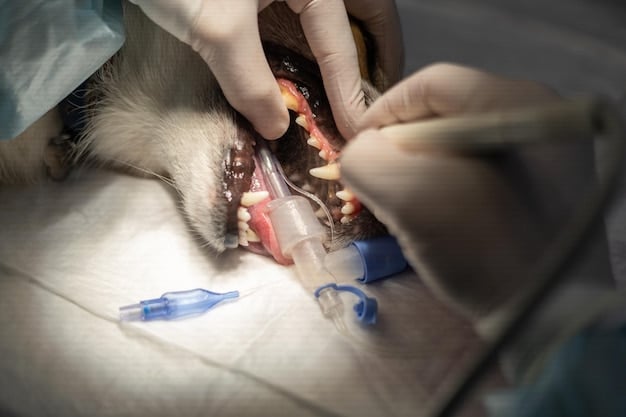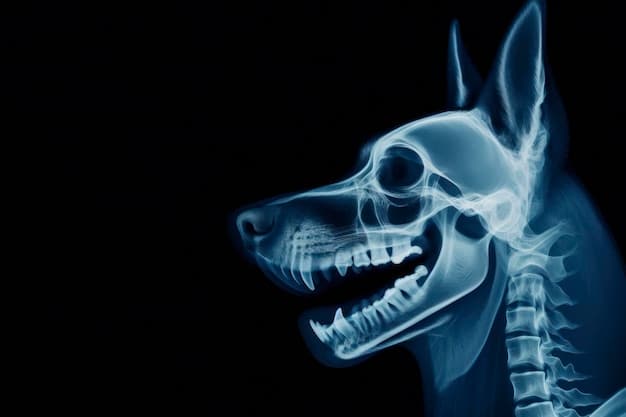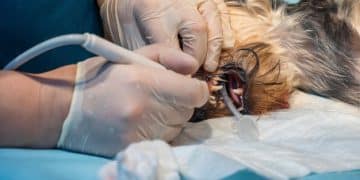Pet Dental Health: How Annual Cleanings Add Years to Your Pet’s Life

The Truth About Pet Dental Health: Why Annual Cleanings Can Extend Your Pet’s Life by 2 Years lies in preventing periodontal disease, which affects 80% of dogs and cats by age three. Regular dental care, including annual cleanings, significantly reduces systemic health risks, potentially adding up to two years to your beloved pet’s life.
Did you know that poor dental health in pets can lead to serious health complications and even shorten their lifespan? Let’s uncover the truth about pet dental health: why annual cleanings can extend your pet’s life by 2 years, and how you can ensure your furry friend lives a longer, healthier life.
Understanding Pet Dental Health and Its Impact
Pet dental health is often overlooked, but it’s crucial for their overall well-being. Just like humans, pets can develop dental problems that lead to pain, infection, and systemic diseases. Understanding these issues is the first step toward ensuring a healthier life for your furry companion.
The Prevalence of Dental Disease in Pets
Dental disease is incredibly common in pets. Studies show that approximately 80% of dogs and 70% of cats show signs of dental disease by the age of three. This high prevalence underscores the importance of preventative dental care from an early age.
How Dental Problems Affect Overall Health
Dental problems aren’t just about bad breath or stained teeth; they can lead to more severe health issues. When bacteria from the mouth enter the bloodstream, they can affect major organs, leading to heart, kidney, and liver diseases.
- Heart Disease: Bacteria can attach to the heart valves, causing inflammation and potentially leading to heart failure.
- Kidney Disease: The kidneys filter toxins from the blood, and chronic inflammation from dental disease can damage their function.
- Liver Disease: The liver processes toxins, and constant exposure to oral bacteria can overwhelm and harm it.
Addressing dental health proactively can mitigate these risks and significantly improve your pet’s overall health and longevity. Regular check-ups and cleanings are essential components of this preventative approach.
In conclusion, dental disease in pets is a widespread issue with serious health consequences. By understanding the prevalence and potential impact of dental problems, pet owners can take proactive steps to ensure their pets live longer, healthier lives. Prioritizing dental health is a crucial aspect of responsible pet ownership.

The Link Between Annual Cleanings and Longevity
Annual dental cleanings are a cornerstone of pet dental health. These professional cleanings go beyond what you can achieve at home, removing plaque and tartar buildup that lead to periodontal disease. This proactive approach can significantly extend your pet’s life.
What Happens During a Professional Dental Cleaning?
A professional dental cleaning, performed by a veterinarian or veterinary dentist, typically involves several steps. First, the pet is placed under anesthesia to ensure a thorough and painless procedure. The veterinarian then uses specialized tools to remove plaque and tartar from above and below the gumline.
The Importance of Removing Plaque and Tartar
Plaque and tartar are breeding grounds for bacteria that cause inflammation and infection in the gums. Removing these substances eliminates the source of the problem and promotes healthier gums and teeth. Regular removal prevents the progression of periodontal disease.
- Reduces Bacterial Load: Decreases the number of harmful bacteria in the mouth, reducing the risk of systemic infections.
- Prevents Gum Recession: Protects the gums from inflammation and recession, preserving tooth support.
- Alleviates Pain and Discomfort: Eliminates the pain associated with infected gums and loose teeth, improving the pet’s quality of life.
In addition to cleaning, the veterinarian will also examine the teeth and gums for any signs of abnormalities, such as fractures, tumors, or infections. Addressing these issues early can prevent them from becoming more serious.
Annual dental cleanings are not just about aesthetics; they are a vital component of preventative healthcare for pets. By removing plaque and tartar, these cleanings reduce the risk of infection, inflammation, and systemic diseases, ultimately contributing to a longer and healthier life for your beloved pet.
Debunking Myths About Pet Dental Care
There are many misconceptions about pet dental care that can prevent owners from taking the necessary steps to protect their pets’ health. Separating fact from fiction is crucial for responsible pet ownership and ensuring optimal dental health.
Myth: Bad Breath is Normal in Pets
Many pet owners believe that bad breath is a natural part of owning a pet, but this is a myth. Persistent bad breath, or halitosis, is often a sign of underlying dental disease. It indicates a buildup of bacteria and infection in the mouth.
Myth: Dry Food Cleans Teeth
While some specially formulated dental diets can help reduce plaque buildup, dry food alone does not clean teeth effectively. The kibble often shatters upon contact with the teeth, providing minimal abrasive action. Dental chews and regular brushing are more effective.
Here are some other common myths about pet dental care:
- Myth: Anesthesia is Unsafe for Dental Cleanings: While anesthesia always carries some risk, modern veterinary anesthesia is generally safe. The benefits of a thorough cleaning under anesthesia far outweigh the risks.
- Myth: You Only Need to Clean Your Pet’s Teeth If They Seem Dirty: Dental disease often develops below the gumline, where it is not visible to the naked eye. Regular cleanings are necessary to address these hidden issues.
Debunking these myths is essential for pet owners to understand the true importance of dental care. By recognizing that bad breath is not normal and that dry food alone is insufficient, owners can take proactive steps to protect their pets’ dental health. This includes regular professional cleanings, home dental care, and a balanced diet.

Implementing a Home Dental Care Routine
While professional cleanings are essential, maintaining a consistent home dental care routine is equally important. Regular brushing, dental chews, and oral rinses can help control plaque buildup and keep your pet’s gums healthy between cleanings.
Brushing Your Pet’s Teeth: A Step-by-Step Guide
Brushing your pet’s teeth may seem daunting, but with patience and the right tools, it can become a routine part of your pet care regimen. Start by introducing your pet to the toothbrush and toothpaste gradually.
Choosing the Right Dental Products
Not all dental products are created equal. It’s essential to choose products specifically designed for pets, as human toothpaste can be toxic to animals. Look for enzymatic toothpastes that help break down plaque and tartar.
Here are some essential components of a home dental care routine:
- Regular Brushing: Aim to brush your pet’s teeth at least two to three times per week.
- Dental Chews: Offer dental chews designed to reduce plaque and tartar buildup.
- Oral Rinses: Use pet-specific oral rinses to help kill bacteria and freshen breath.
- Dental Diets: Consider feeding a dental diet formulated to reduce plaque and tartar.
Implementing a home dental care routine may take time and patience, but the benefits are well worth the effort. Regular brushing, dental chews, and oral rinses can help prevent dental disease and keep your pet’s mouth healthy between professional cleanings. Consistency is key to success.
Recognizing Signs of Dental Problems in Pets
Even with regular dental care, it’s important to be vigilant and recognize the signs of dental problems in pets. Early detection and treatment can prevent more serious complications and improve your pet’s quality of life. Knowing what to look for can make all the difference.
Common Symptoms of Dental Disease
Several symptoms can indicate dental problems in pets. These include bad breath, excessive drooling, difficulty chewing, and a reluctance to eat hard food. Other signs may include pawing at the mouth, swollen gums, and loose teeth.
When to Consult a Veterinarian
If you notice any of these symptoms, it’s important to consult a veterinarian as soon as possible. Prompt treatment can prevent the condition from worsening and alleviate your pet’s discomfort. Your veterinarian can perform a thorough examination and recommend appropriate treatment options.
Be aware of these warning signs to detect potential dental issues early:
- Changes in Eating Habits: A sudden reluctance to eat or a preference for soft food can indicate dental pain.
- Facial Swelling: Swelling on one side of the face can be a sign of an abscessed tooth.
- Bleeding Gums: Bleeding gums are a clear indication of inflammation and infection.
Recognizing the signs of dental problems in pets is essential for early intervention and effective treatment. By being vigilant and consulting a veterinarian promptly, pet owners can protect their pets’ dental health and prevent more serious complications.
The Cost of Neglecting Pet Dental Health
Neglecting pet dental health can lead to significant financial burdens in addition to health complications. Understanding the long-term costs associated with untreated dental disease can help owners appreciate the value of preventative care. Proactive care is an investment in your pet’s overall well-being.
Financial Implications of Dental Disease
The cost of treating advanced dental disease can be substantial. Procedures such as tooth extractions, root canals, and gum surgery can be expensive, and the associated medications and follow-up visits add to the financial burden. Preventative care is generally more cost-effective in the long run.
The Long-Term Savings of Preventative Care
Investing in regular dental cleanings and home dental care can save you money in the long term. By preventing dental disease, you can avoid costly treatments and reduce the risk of other health complications that may require additional veterinary care.
Consider these potential costs associated with neglecting pet dental health:
- Expensive Procedures: Tooth extractions and other advanced dental treatments can be costly.
- Medications: Antibiotics and pain medications may be necessary to treat infections and alleviate discomfort.
- Related Health Issues: Dental disease can lead to heart, kidney, and liver problems, which require additional treatment.
Neglecting pet dental health can have serious financial implications in addition to health risks. By investing in preventative care, such as annual dental cleanings and a consistent home dental care routine, pet owners can save money in the long term and ensure their pets enjoy a healthier, happier life.
| Key Point 🔑 | Brief Description 📝 |
|---|---|
| Annual Cleanings 🗓️ | Professional removal of plaque and tartar, crucial for preventing dental disease. |
| Home Dental Care 🏡 | Regular brushing, dental chews, and oral rinses to maintain oral hygiene. |
| Dental Disease Risks ⚠️ | Untreated dental issues can lead to heart, kidney, and liver diseases. |
| Early Detection 🔍 | Recognizing symptoms like bad breath and difficulty chewing is key. |
Frequently Asked Questions (FAQ)
What are the risks of skipping annual dental cleanings for my pet?
▼
How often should I brush my pet’s teeth at home?
▼
Can dental chews replace professional **dental** cleanings?
▼
Is anesthesia always necessary for pet **dental** cleanings?
▼
What are the early signs of **dental** issues in pets?
▼
Conclusion
In conclusion, prioritizing your pet’s dental health is crucial for their overall well-being and longevity. Annual dental cleanings, combined with a consistent home dental care routine, can significantly reduce the risk of dental disease and its associated health complications. By taking proactive steps to care for your pet’s teeth, you can help them live a longer, happier, and healthier life.
Read more content





